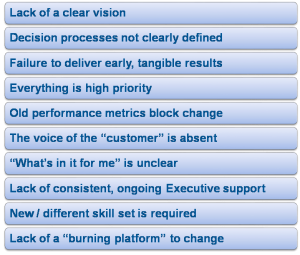No, there is no typo in the title – the C stands for CHANGE. I am working on a presentation for an ISM dinner meeting in Pittsburgh next week entitled “Sourcing IS Change Management” which was first delivered at a Sourcing Interest Group conference back in 1998 (of course I am updating it 🙂 !). As I am thinking about my approach, I am reflecting on the fact that almost 20 years later the issues we talked about back then are the SAME issues we face today. Moving from tactical buying to Procurement to Strategic Sourcing to Category Management requires a major change (Transformation – big T) for any organization and CHANGE IS HARD.
In a recent article published by McKinsey “Transformation with a capital T” the authors note that “the reported failure rate of large-scale change programs has hovered around 70% over many years”. The article goes on to provide some thoughts as to why there is such a high failure rate. Here is TMG’s list of why change efforts fail:
If you doubt that change management is critical to Sourcing, let me help you out. To be successful at any level of purchasing beyond Traditional Purchasing in our Maturity Model a major change MUST occur.
Since it takes many years to move up the maturity model (and the model keeps expanding to the right over time as well), the change is long, hard and requires a great deal of commitment. Many organizations go into the Transformation believing that if they change the process, some or even all of the people and introduce new technology, they will be home free. What they fail to understand is that taking those steps does not help to get through the issues noted above.
I thought McKinsey’s insights on how to improve your odds for success were spot on. They are based on a fundamental lesson they have learned – “average companies rarely have the combination of skills, mind-sets, and ongoing commitment needed to pull off a large-scale transformation”. Here are some of their insights supplemented with a few thoughts of my own.
- Need “a CEO who recognizes that only a new approach will dramatically improve the company’s performance.” I would suggest that if not the CEO, then another C level executive must actively sponsor your change effort to ensure that organizational inertia toward the status quo is overcome.
- “Stretch for the full potential. Targets in most organizations emerge from negotiations . . . . which leads to compromises and incremental changes rather than radical improvement”. I have found that stretch targets (backed by facts) are critical and mostly achievable – teams DO step up and meet their stretch goals time after time.
- “Change the cadence . . . . . create a hub to oversee the transformation to drive a cadence markedly different from the normal day-to-day one”. In other words, create a transformation office (“TO”) that makes your change initiative a priority and does not get bogged down in the day to day operation of the business.
- “Bring on the CTO. The chief transformation officer’s job is to question, push, praise, cajole and otherwise irritate an organization that needs to think and act differently”. You need someone at the executive level who will challenge the status quo every single day and be that ultimate change agent.
- “Remove barriers, create incentives”. In my experience, the barriers will be many and most will be internal. They MUST be addressed early and decisively – this is a key element of change management. Providing incentives is also important because going through a transformation requires changes in employee behavior and this is a tough thing to do.
- “No going back. The true test of a transformation, therefore, is what happens when the TO is disbanded and life reverts to a more normal rhythm. Embedding the processes and working approaches of the transformation into everyday activities . . . to ensure that the momentum of the performance continues to accelerate after the transformation is over.” It’s all about ADOPTION, ADOPTION, ADOPTION and it is the hardest part of the change – ensuring that the investment has an ongoing return and the change is sustainable.
Going through a Transformation – I lead more than a few in my career personally and with client organizations – is tough. Nothing could be more difficult or more rewarding but at its core it is ALL about change management with a capital C.
Let us know what you think and join in the conversation. . . . . . .




2 Comments
Pingback: Do You Know the Difference Between Strategic Sourcing and Category Management? The Why? - News You Can Use
Pingback: Why Worry About Metrics? - News You Can Use